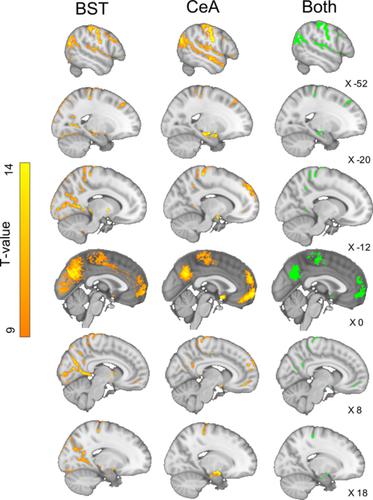当前位置:
X-MOL 学术
›
Hum. Brain Mapp.
›
论文详情
Our official English website, www.x-mol.net, welcomes your
feedback! (Note: you will need to create a separate account there.)
Extended‐amygdala intrinsic functional connectivity networks: A population study
Human Brain Mapping ( IF 3.5 ) Pub Date : 2020-12-12 , DOI: 10.1002/hbm.25314 Samuel C Berry 1 , Richard G Wise 2 , Andrew D Lawrence 1 , Thomas M Lancaster 3
Human Brain Mapping ( IF 3.5 ) Pub Date : 2020-12-12 , DOI: 10.1002/hbm.25314 Samuel C Berry 1 , Richard G Wise 2 , Andrew D Lawrence 1 , Thomas M Lancaster 3
Affiliation

|
Pre‐clinical and human neuroimaging research implicates the extended‐amygdala (ExtA) (including the bed nucleus of the stria terminalis [BST] and central nucleus of the amygdala [CeA]) in networks mediating negative emotional states associated with stress and substance‐use behaviours. The extent to which individual ExtA structures form a functionally integrated unit is controversial. We utilised a large sample (n > 1,000 healthy young adult humans) to compare the intrinsic functional connectivity networks (ICNs) of the BST and CeA using task‐free functional magnetic resonance imaging (fMRI) data from the Human Connectome Project. We assessed whether inter‐individual differences within these ICNs were related to two principal components representing negative disposition and alcohol use. Building on recent primate evidence, we tested whether within BST‐CeA intrinsic functional connectivity (iFC) was heritable and further examined co‐heritability with our principal components. We demonstrate the BST and CeA to have discrete, but largely overlapping ICNs similar to previous findings. We found no evidence that within BST—CeA iFC was heritable; however, post hoc analyses found significant BST iFC heritability with the broader superficial and centromedial amygdala regions. There were no significant correlations or co‐heritability associations with our principal components either across the ICNs or for specific BST‐Amygdala iFC. Possible differences in phenotype associations across task‐free, task‐based, and clinical fMRI are discussed, along with suggestions for more causal investigative paradigms that make use of the now well‐established ExtA ICNs.
中文翻译:

扩展杏仁核内在功能连接网络:一项群体研究
临床前和人类神经影像学研究表明,扩展杏仁核 (ExtA)(包括终纹床核 [BST] 和杏仁核中央核 [CeA])参与调节与压力和物质使用相关的负面情绪状态的网络行为。各个 ExtA 结构在多大程度上形成功能集成单元存在争议。我们利用大样本( n > 1,000 名健康年轻人)使用来自人类连接组项目的无任务功能磁共振成像 (fMRI) 数据来比较 BST 和 CeA 的内在功能连接网络 (ICN)。我们评估了这些 ICN 中的个体差异是否与代表消极倾向和饮酒的两个主要成分有关。基于最近的灵长类动物证据,我们测试了 BST-CeA 内部功能连接 (iFC) 是否可遗传,并进一步检查了与我们的主要成分的共遗传性。我们证明 BST 和 CeA 具有离散但很大程度上重叠的 ICN,类似于之前的发现。我们没有发现任何证据表明 BST-CeA iFC 是可遗传的;然而,事后分析发现,BST iFC 在更广泛的浅层和中心内侧杏仁核区域具有显着的遗传性。无论是在 ICN 中还是在特定的 BST-杏仁核 iFC 中,与我们的主要成分都没有显着的相关性或共同遗传性关联。讨论了无任务、基于任务和临床 fMRI 之间表型关联可能存在的差异,并提出了利用现已完善的 ExtA ICN 进行更多因果研究范式的建议。
更新日期:2020-12-12
中文翻译:

扩展杏仁核内在功能连接网络:一项群体研究
临床前和人类神经影像学研究表明,扩展杏仁核 (ExtA)(包括终纹床核 [BST] 和杏仁核中央核 [CeA])参与调节与压力和物质使用相关的负面情绪状态的网络行为。各个 ExtA 结构在多大程度上形成功能集成单元存在争议。我们利用大样本( n > 1,000 名健康年轻人)使用来自人类连接组项目的无任务功能磁共振成像 (fMRI) 数据来比较 BST 和 CeA 的内在功能连接网络 (ICN)。我们评估了这些 ICN 中的个体差异是否与代表消极倾向和饮酒的两个主要成分有关。基于最近的灵长类动物证据,我们测试了 BST-CeA 内部功能连接 (iFC) 是否可遗传,并进一步检查了与我们的主要成分的共遗传性。我们证明 BST 和 CeA 具有离散但很大程度上重叠的 ICN,类似于之前的发现。我们没有发现任何证据表明 BST-CeA iFC 是可遗传的;然而,事后分析发现,BST iFC 在更广泛的浅层和中心内侧杏仁核区域具有显着的遗传性。无论是在 ICN 中还是在特定的 BST-杏仁核 iFC 中,与我们的主要成分都没有显着的相关性或共同遗传性关联。讨论了无任务、基于任务和临床 fMRI 之间表型关联可能存在的差异,并提出了利用现已完善的 ExtA ICN 进行更多因果研究范式的建议。











































 京公网安备 11010802027423号
京公网安备 11010802027423号